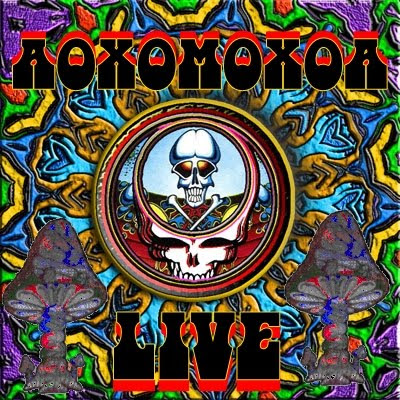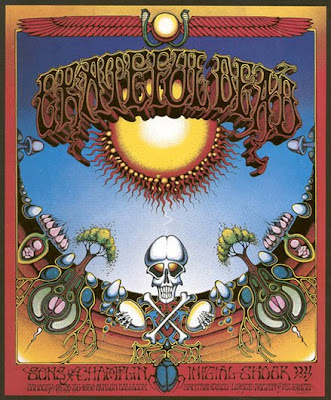 Here's a twist from the rotation of shows (somewhat) I have put together a composite of "live" tracks from various other shows to give us an AOXOMOXOA show. From the bands most psychedelic time frame when experimentation in the their music and their life style was at it's zenith. It is no wonder that many of the songs on this LP were really not played a lot over the years as only St Stephen and China Cat became staples in the bands rotation. Enjoy the Grateful Dead at their psychedelic best! This one of my favorite GD LP's . A really fun listen!
Here's a twist from the rotation of shows (somewhat) I have put together a composite of "live" tracks from various other shows to give us an AOXOMOXOA show. From the bands most psychedelic time frame when experimentation in the their music and their life style was at it's zenith. It is no wonder that many of the songs on this LP were really not played a lot over the years as only St Stephen and China Cat became staples in the bands rotation. Enjoy the Grateful Dead at their psychedelic best! This one of my favorite GD LP's . A really fun listen!Tracks
- St. Stephen (Garcia/Lesh/Hunter) 1-23-70 Honolulu
- Dupree's Diamond Blues (Garcia/Hunter) 1-24-69 San Francisco
- Rosemary (Garcia/Hunter) 12-7-68 Louisville
- Doin' That Rag (Garcia/Hunter) 1-24-69 San Francisco
- Mountains Of The Moon (Garcia/Hunter) 4-26-69 Chicago
- China Cat Sunflower (Garcia/Hunter) 2-13-68 San Francisco
- What's Become Of The Baby (Garcia/Hunter) 4-26-69 Chicago
- Cosmic Charlie (Garcia/Hunter) 1-16-70 Portland
Aoxomoxoa is the third studio album by the Grateful Dead. It was originally titled Earthquake Country. Many Deadheads consider this era of the Dead to be the experimental apex of the band's history. It is also the first album with Tom Constanten as an official member of the band.
The title of the album is a palindrome created by cover artist Rick Griffin and lyricist Robert Hunter. According to the audio version of the Rock Scully memoir, Living with the Dead (read by the author and former Dead co-manager himself), the title is pronounced "ox-oh-mox-oh-ah". The words "Grateful Dead" on the front of the album, written in large, flowing capital letters, are an ambigram that can also be read "we ate the acid". The artwork around the bottom edge of the album cover depicts several phallic representations.

The word "AOXOMOXOA," is a double palindrome, meaning not only does it read the same forward and backward, but also each letter in the word is also reversible, and when flipped horizontally also reads the same either way. As the story goes, "AOXOMOXOA," was an idea given to Rick Griffin by Grateful Dead lyricist Robert Hunter, when Griffin phoned him up and asked him for a possible title for the new Grateful Dead album cover Griffin was working on. Hunter suggested that he put a lot of the palindromes that Griffin had been playing with (words like 'mom,' etc.,) together to form a larger word.
Dead Heads have speculated as to the possible meaning of the word, with thoughts like the "AO" means "Alpha and Omega," the sacred seed syllable "OM" is in the center, "X" is a mysterious number to be solved for, and so on. Others have speculated that this is an Aztec or Mayan word. Beyond the word is the actual imagery created by Rick Griffin.
Griffin's incredible sun (an egg surrounded by sperm wriggling to get in), burning in a clear blue sky, endlessly radiating light and warmth above, warming the earth below, where the most dark womb of the earth receives that light and (also endlessly) brings forth life. Here is the mystery of life and death drawn out in psychedelic imagery worthy of Carlos Castaneda and the mysterious world of Don Juan. This poster has an immediate and a lasting impact on our consciousness. For me, it is unique in the world of psychedelic posters and is the single most important graphic from that era.
And if these incredible graphics don't speak for themselves, Griffin thought to literally spell it out for us in the very type on the poster itself, the name: Grateful Dead. If you cover the lower two-thirds portion of the name "Grateful Dead," the very top third spells out for all of us the very truth of that time, the very essence of the psychedelic experience. It clearly says "We Ate The Acid," and that says it all. We ate the acid and it changed our life and set the tone for a generation.
In 1991 Rolling Stone selected Aoxomoxoa as having the eighth best album cover of all time. A five-year-old Courtney Love appears on the album's back cover.
The group had already initiated recording sessions for the album when Ampex manufactured and released the first Multitrack recording machine offering 16 tracks of recording and playback (model number MM-1000). This doubled the number of tracks the band had available when they recorded Anthem of the Sun the previous year. As a direct consequence, the band spent eight months off-and-on in the studio not only recording the album but getting used to—and experimenting with—the new technology. Garcia commented that "it was our first adventure with sixteen-track and we tended to put too much on everything...A lot of the music was just lost in the mix, a lot of what was really there."As a result, Garcia and Lesh went back in the studio in 1971 to remix the album, removing whole sections of songs. The result, with the same catalog number, WS1790, but with much of the original's experimental character removed, can be identified by the legend on the back cover that reads, "Remixed September, 1971". The original mix was later planned for CD release, but the original master tapes could not be located. The master tapes were finally located for The Warner Bros. Studio Albums vinyl box set, marking the first time the 1969 mix has been available since the 1971 remix replaced it.
In Grateful Dead history, Aoxomoxoa had a number of firsts connected with it. It is the first album the band recorded in or near their hometown of San Francisco (at Pacific Recording Studio in nearby San Mateo, and at the similarly named Pacific High Recording Studio in San Francisco proper). It is the first studio release to include pianist Tom Constanten as a permanent member. It was also the first to have lyricist Robert Hunter as a full-time contributor to the band, thus initiating the Jerry Garcia/Robert Hunter songwriting partnership that endured for the rest of the band's existence. It was also the first time the band would put emphasis on acoustic songs, such as "Mountains of the Moon" and "Dupree's Diamond Blues." Lesh played acoustic bass for the first time, commenting that "the fun part of that was trying to play in tune with no frets to guide my fingers, just like a violin."
The lengthy sessions for the album would put the band deeper into debt with Warner Bros. Records—specifically, a total cost of $180,000 for Aoxomoxoa, it was their most ambitious and costly venture to that date. It would be the last time the band would ever run up such high studio bills.
Musicians
